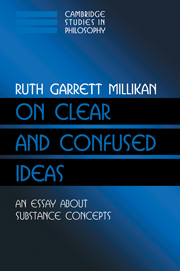Book contents
- Frontmatter
- Contents
- Preface
- Chapter 1 Introducing Substance Concepts
- Chapter 2 Substances: The Ontology
- Chapter 3 Classifying, Identifying, and the Function of Substance Concepts
- Chapter 4 The Nature of Abilities: How Is Extension Determined?
- Chapter 5 More Mama, More Milk and More Mouse: The Structure and Development of Substance Concepts
- Chapter 6 Substance Concepts Through Language: Knowing the Meanings of Words
- Chapter 7 How We Make Our Ideas Clear: Epistemology for Empirical Concepts
- Chapter 8 Content and Vehicle in Perception
- Chapter 9 Sames Versus Sameness in Conceptual Contents and Vehicles
- Chapter 10 Grasping Sameness
- Chapter 11 In Search of Strawsonian Modes of Presentation
- Chapter 12 Rejecting Identity Judgments and Fregean Modes
- Chapter 13 Knowing What I'm Thinking Of
- Chapter 14 How Extensions of New Substance Concepts are Fixed: How Substance Concepts Acquire Intentionality
- Chapter 15 Cognitive Luck: Substance Concepts in an Evolutionary Frame
- Appendix A Contrast with Evans on Information-Based Thoughts
- Appendix B What Has Natural Information to Do with Intentional Representation?
- References
- Index
Chapter 1 - Introducing Substance Concepts
Published online by Cambridge University Press: 02 December 2009
- Frontmatter
- Contents
- Preface
- Chapter 1 Introducing Substance Concepts
- Chapter 2 Substances: The Ontology
- Chapter 3 Classifying, Identifying, and the Function of Substance Concepts
- Chapter 4 The Nature of Abilities: How Is Extension Determined?
- Chapter 5 More Mama, More Milk and More Mouse: The Structure and Development of Substance Concepts
- Chapter 6 Substance Concepts Through Language: Knowing the Meanings of Words
- Chapter 7 How We Make Our Ideas Clear: Epistemology for Empirical Concepts
- Chapter 8 Content and Vehicle in Perception
- Chapter 9 Sames Versus Sameness in Conceptual Contents and Vehicles
- Chapter 10 Grasping Sameness
- Chapter 11 In Search of Strawsonian Modes of Presentation
- Chapter 12 Rejecting Identity Judgments and Fregean Modes
- Chapter 13 Knowing What I'm Thinking Of
- Chapter 14 How Extensions of New Substance Concepts are Fixed: How Substance Concepts Acquire Intentionality
- Chapter 15 Cognitive Luck: Substance Concepts in an Evolutionary Frame
- Appendix A Contrast with Evans on Information-Based Thoughts
- Appendix B What Has Natural Information to Do with Intentional Representation?
- References
- Index
Summary
ONE SPECIAL KIND OF CONCEPT
One use of the word “concept” equates a concept with whatever it is one has to learn in order to use a certain word correctly. So we can talk of the concept or and the concept of and the concepts hurrah, the, because, necessarily, ouch, good, true, two, exists, is – and so forth. We can talk that way, but then we should remember Wittgenstein's warning: “Think of the tools in a toolbox: there is a hammer, pliers, a saw, a screwdriver, a glue pot, nails and screws – The functions of words are as diverse as the functions of these objects” (1953, Section 11). Given this broad usage of “concept,” there will be little or nothing in common about any two of these various concepts. We mustn't expect a theory of how the tape measure works to double as a theory of how the glue works.
In this book, I propose a thesis about the nature of one and only one kind of concept, namely, concepts of what (with a respectful nod to Aristotle) I call “substances.” Paradigmatic substances, in my sense, are individuals (Mama, The Empire State Building), stuffs (gold, milk), and natural kinds (mouse, geode). The core of the theory is not, however, about grasp of the use of words for substances (although I will get to that). Rather, the core belongs to the general theory of cognition, in exactly the same way that theories of perception do. Substance concepts are primarily things we use to think with rather than to talk with.
Information
- Type
- Chapter
- Information
- On Clear and Confused IdeasAn Essay about Substance Concepts, pp. 1 - 14Publisher: Cambridge University PressPrint publication year: 2000
Accessibility standard: Unknown
Why this information is here
This section outlines the accessibility features of this content - including support for screen readers, full keyboard navigation and high-contrast display options. This may not be relevant for you.Accessibility Information
- 1
- Cited by
